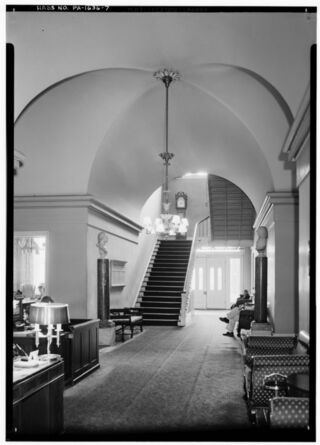Psychiatry
Five Historic American Mental Hospitals
A brief history of some of America's most storied psychiatric institutions.
Posted February 6, 2021 Reviewed by Ekua Hagan
Mental hospitals have played a role of paramount importance in the history of American psychiatry, dating back to the mid-18th century when the Quakers made the first organized attempt to care for the mentally ill. These institutions have long been the subject of public lore and curiosity, along with a dose of suspicion. Some of the most historic hospitals continue to operate, yet others, unfortunately, sit abandoned and crumble as the years pass.
What follows is a list of five historically noteworthy hospitals in the U.S., each important for its own reasons. They are listed in no particular order. For a more general (brief) history of the American mental hospital, readers can see my post here.
The Institute of the Pennsylvania Hospital
Founded by Dr. Thomas Bond and Benjamin Franklin, the Pennsylvania Hospital was the nation's first to care for the poor and disenfranchised. It was also the first to treat mental disorders as conditions that could be effectively cured (Penn Medicine, 2021). The "Father of American Psychiatry," Benjamin Rush, was appointed to its staff in 1783 and served until his death in 1813. (Rush was also a signer of the Declaration of Independence.)

In 1840, the 31-year-old Dr. Thomas Story Kirkbride, a graduate of the University of Pennsylvania, was named Superintendent of the Pennsylvania Hospital for the Insane, which had recently been constructed in West Philadelphia to accommodate the city's growing mentally ill population. The reputation of the hospital grew, and Kirkbride reached international acclaim upon publishing his "Kirkbride Plan" for mental hospital construction, outlined in an 1854 paper. Kirkbride is also widely known for becoming the first president of the organization which later became known as the American Psychiatric Association.
In the 20th century, the hospital, which had been renamed the Pennsylvania Hospital for Mental and Nervous Diseases, was at the forefront of advances in psychiatric and psychoanalytic medicine. The hospital was closed permanently in 1997 due, in part, to decreased insurance payment for inpatient psychiatric stays. It still stands in Philadelphia as the world's pioneer example of a Kirkbride Plan hospital.
Pilgrim State Hospital
Located in Brentwood, New York, Pilgrim State Hospital was the largest psychiatric hospital—and hospital of any kind—in the history of the world. At the peak of psychiatric institutionalization in 1954, it housed 13,875 patients (New York State Office of Mental Health, 2012). Its size has never been exceeded by any other facility.

Due to mass waves of immigration to New York City in the late 19th and early 20th centuries, overcrowding at the city's asylums became a major problem. In response, several large hospitals were constructed on Long Island, then a rural area, including King's Park State Hospital, Central Islip State Hospital, and Pilgrim State. These new institutions were dubbed "farm colonies," since patients would participate in agricultural work as an element of their treatment. Soon, these facilities, too, would become overcrowded.
After the introduction of the early psychotropic drugs in the 1950s—most notably, Thorazine—these massive facilities began a process of "deinstitutionalization," and many long-term patients were discharged to the community. Unfortunately, a lack of funding left many of the most severely ill without access to proper care—a problem that continues to plague the American mental health system to this day. Pilgrim State Hospital remains open as Pilgrim Psychiatric Center, though at a greatly reduced capacity.
Bellevue Hospital
Founded in 1736, Bellevue Hospital in New York City is the oldest public hospital in the United States. It opened its first psychiatric ward in 1879 and its first alcoholic ward in 1892. In 1931, a separate hospital building was constructed in the Italian Renaissance style adjacent to the main hospital to house the department of psychiatry.

Though Bellevue has been the site of many significant contributions in the history of general medicine and surgery (including, for instance, the first mitral valve replacement and the first successful operation of the abdomen for a gunshot wound), the hospital has been most closely associated with its treatment of New York's mentally ill. For decades, the name "Bellevue" was synonymous with inpatient psychiatric care (see Oshinsky, 2016, for an excellent history).
The city began phasing out Bellevue Psychiatric Hospital in the 1980s, and by 1998, it had been fully transformed into a homeless shelter. Psychiatric patients are now treated in one of eight inpatient units located in Bellevue's main hospital building.
The Sheppard and Enoch Pratt Hospital
Built according to the Kirkbride Plan and opened in 1891, The Sheppard and Enoch Pratt Hospital in Towson, Maryland, has long been regarded as one of America's most exceptional hospitals for the treatment of psychiatric illness.

The hospital played a central role in the history of American psychoanalysis, becoming an epicenter for hospital psychoanalysis in the early and mid-20th century. Another area where Sheppard Pratt was at the forefront of psychiatric medicine was in the understanding that specialized care is often needed for patients of certain age groups, including children and the elderly. Successful day programs were implemented in the 1960s, and the hospital introduced a research department in 1968 (Sheppard Pratt Health System, 2021).
Today, Sheppard Pratt remains a leading center for psychiatry and has undergone major expansions in the past 20 years. One program, The Retreat at Sheppard Pratt, offers long-term, psychotherapy-based, intensive inpatient treatment unencumbered by the policies of third-party payers. The hospital has been listed as a U.S. National Historic Landmark since 1971.
Florida State Hospital
Established in 1876, Florida State Hospital in Chattahoochee was Florida's only state mental institution until 1947. The hospital was at the center of the landmark 1975 U.S. Supreme Court case O'Connor v. Donaldson, which established that it is unconstitutional to confine a nondangerous person who is capable of living safely in the community with the help of family or friends. This accelerated the broader deinstitutionalization movement, which had been sparked more than a decade earlier by the advent of neuroleptic medicine and other factors.

Florida State Hospital remains in operation today, mainly as an institution for those who are forensically committed or have been found not guilty by reason of insanity (Florida Department of Children and Families, 2021). The hospital's administration building is listed on the U.S. National Register of Historic Places.
References
Florida Department of Children and Families. (2021). Florida State Hospital. https://www.myflfamilies.com/service-programs/mental-health/fsh/about-u…
Kirkbride, T.S. (1854). On the construction, organization, and general arrangements of hospitals for the insane. Philadephia, PA: (n.p.).
New York State Office of Mental Health. (2012). Pilgrim Psychiatric Center. https://web.archive.org/web/20120330034840/http://www.omh.ny.gov/omhweb…
Oshinsky, D. (2016). Bellevue: Three centuries of medicine and mayhem at America's most storied hospital. Anchor Books.
Penn Medicine. (2017). Pennsylvania Hospital history: Institute of Pennsylvania Hospital. https://www.uphs.upenn.edu/paharc/collections/finding/iphgeneral.html
Sheppard Pratt Health System. (2021). History. https://www.sheppardpratt.org/why-sheppard-pratt/history/




